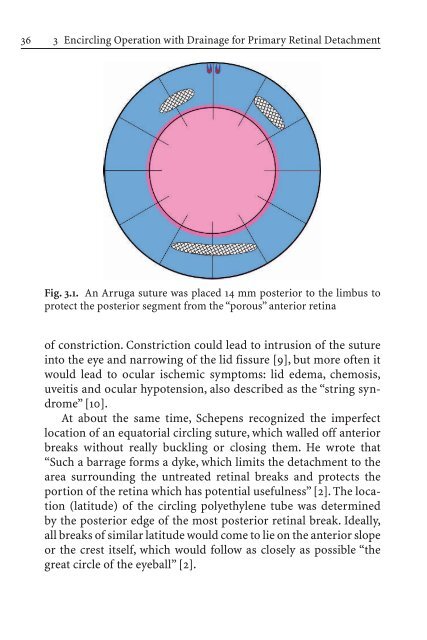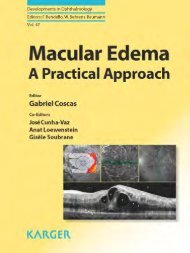- Page 2 and 3: Ingrid Kreissig (Ed.) Primary Retin
- Page 4 and 5: Professor Dr. med. Ingrid Kreissig
- Page 6 and 7: Contents 1 The History of Retinal D
- Page 8 and 9: List of Contributors Gary W. Abrams
- Page 10 and 11: List of Contributors XI Hermann D.
- Page 12 and 13: 2 Helmholz in 1850 made an accurate
- Page 14 and 15: 4 (vitreous, gelatin) into the ante
- Page 16 and 17: 6 with scleral resection that set t
- Page 18 and 19: 8 ditis [72-74].Temperatures up to
- Page 20 and 21: 10 1 The History of Retinal Detachm
- Page 22 and 23: 12 1 The History of Retinal Detachm
- Page 24 and 25: 14 1 The History of Retinal Detachm
- Page 26 and 27: 16 ion [147]. Perfluorocarbon liqui
- Page 28 and 29: 18 1 The History of Retinal Detachm
- Page 30 and 31: 20 1 The History of Retinal Detachm
- Page 32 and 33: 22 1 The History of Retinal Detachm
- Page 34 and 35: 24 1 The History of Retinal Detachm
- Page 36 and 37: 26 2 Prophylaxis in Fellow Eye of P
- Page 38 and 39: 28 2 Prophylaxis in Fellow Eye of P
- Page 40 and 41: 30 2 Prophylaxis in Fellow Eye of P
- Page 42 and 43: 32 found that eyes with pre-existin
- Page 44 and 45: 34 2 Prophylaxis in Fellow Eye of P
- Page 48 and 49: 38 3 Encircling Operation with Drai
- Page 50 and 51: 40 3 Encircling Operation with Drai
- Page 52 and 53: 42 3 Encircling Operation with Drai
- Page 54 and 55: 44 3 Encircling Operation with Drai
- Page 56 and 57: 46 3 Encircling Operation with Drai
- Page 58 and 59: 48 3 Encircling Operation with Drai
- Page 60 and 61: 50 3 Encircling Operation with Drai
- Page 62 and 63: 52 3 Encircling Operation with Drai
- Page 64 and 65: Chapter 4 Pneumatic Retinopexy for
- Page 66 and 67: Technique 57 Case Selection Proper
- Page 68 and 69: Technique 59 Table 4.1. Gas charact
- Page 70 and 71: Technique 61 solution; however,thes
- Page 72 and 73: Technique 63 gas reflux. Following
- Page 74 and 75: Complications: Prevention and Manag
- Page 76 and 77: New Possibilities 67 ing on type an
- Page 78 and 79: Results 69 Table 4.7 (continued) Au
- Page 80 and 81: Discussion 71 surgical failures. Fa
- Page 82 and 83: Discussion 73 Disadvantages of PR A
- Page 84 and 85: References 75 situations, then to p
- Page 86 and 87: References 77 24. Tornambe PE, Hilt
- Page 88 and 89: References 79 51. Pournaras CJ, Don
- Page 90 and 91: Chapter 5 Vitrectomy for the Primar
- Page 92 and 93: Indications 83 Table 5.1. Indicatio
- Page 94 and 95: Indications 85 Fig. 5.2. The vitreo
- Page 96 and 97:
Surgical Technique 87 vitrectomy an
- Page 98 and 99:
Outcomes 89 will be visible under a
- Page 100 and 101:
Outcomes 91 almost no persistent su
- Page 102 and 103:
References 93 7. Heimann H, Bornfel
- Page 104 and 105:
96 6 Minimal Segmental Buckling Wit
- Page 106 and 107:
98 6 Minimal Segmental Buckling Wit
- Page 108 and 109:
100 the operating table with the re
- Page 110 and 111:
102 6 Minimal Segmental Buckling Wi
- Page 112 and 113:
104 6 Minimal Segmental Buckling Wi
- Page 114 and 115:
106 a b 6 Minimal Segmental Bucklin
- Page 116 and 117:
108 a b 6 Minimal Segmental Bucklin
- Page 118 and 119:
110 6 Minimal Segmental Buckling Wi
- Page 120 and 121:
112 6 Minimal Segmental Buckling Wi
- Page 122 and 123:
114 a 6 Minimal Segmental Buckling
- Page 124 and 125:
116 a b 6 Minimal Segmental Bucklin
- Page 126 and 127:
118 6 Minimal Segmental Buckling Wi
- Page 128 and 129:
120 6 Minimal Segmental Buckling Wi
- Page 130 and 131:
122 c d 6 Minimal Segmental Bucklin
- Page 132 and 133:
124 c Fig. 6.14c 6 Minimal Segmenta
- Page 134 and 135:
Table 6.1. Preoperative characteris
- Page 136 and 137:
Table 6.3. Final attachment after m
- Page 138 and 139:
130 Choroidals In 4 of the 1,462 de
- Page 140 and 141:
Table 6.4. Visual acuity at 2 years
- Page 142 and 143:
134 6 Minimal Segmental Buckling Wi
- Page 144 and 145:
136 6 Minimal Segmental Buckling Wi
- Page 146 and 147:
138 6 Minimal Segmental Buckling Wi
- Page 148 and 149:
140 Probably, the future question n
- Page 150 and 151:
142 6 Minimal Segmental Buckling Wi
- Page 152 and 153:
144 6 Minimal Segmental Buckling Wi
- Page 154 and 155:
146 7 Pharmacological Approaches to
- Page 156 and 157:
148 7 Pharmacological Approaches to
- Page 158 and 159:
150 7 Pharmacological Approaches to
- Page 160 and 161:
152 heparin was published in eyes u
- Page 162 and 163:
154 search for compounds with hepar
- Page 164 and 165:
156 7 Pharmacological Approaches to
- Page 166 and 167:
158 7 Pharmacological Approaches to
- Page 168 and 169:
Chapter 8 Systematic Review of Effi
- Page 170 and 171:
Materials and Methods 163 Table 8.2
- Page 172 and 173:
Discussion 165 30% 25% 20% 15% 10%
- Page 174 and 175:
Discussion 167 Fig. 8.2. The small
- Page 176 and 177:
Conclusion 169 vitrectomy and searc
- Page 178 and 179:
References 171 8. Brazitikos PD, D
- Page 180 and 181:
References 173 34. Gunduz K, Gunalp
- Page 182 and 183:
References 175 63. Schepens CL (195
- Page 184 and 185:
178 9 Repair of Primary Retinal Det
- Page 186 and 187:
180 a b Fig. 9.3a,b. Legend see pag
- Page 188 and 189:
182 9 Repair of Primary Retinal Det
- Page 190 and 191:
184 9 Repair of Primary Retinal Det
- Page 192 and 193:
186 a b 9 Repair of Primary Retinal
- Page 194 and 195:
188 might eliminate traction on the
- Page 196 and 197:
190 9 Repair of Primary Retinal Det
- Page 198 and 199:
Chapter 10 Retinal Detachment Repai
- Page 200 and 201:
Retinal Detachment Repair: Outlook
- Page 202 and 203:
Retinal Detachment Repair: Outlook
- Page 204 and 205:
Retinal Detachment Repair: Outlook
- Page 206 and 207:
Retinal Detachment Repair: Outlook
- Page 208 and 209:
Retinal Detachment Repair: Outlook
- Page 210 and 211:
Retinal Detachment Repair: Outlook
- Page 212 and 213:
References 207 It is impossible to
- Page 214 and 215:
210 C Campbell 7 case selection 57,
- Page 216 and 217:
212 M Machemer 13 macular - complic
- Page 218 and 219:
214 retinal - detachment - - bilate





